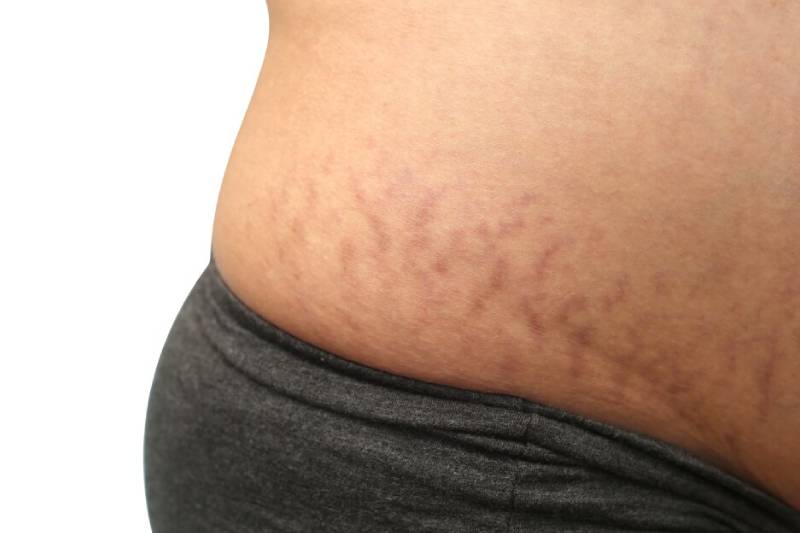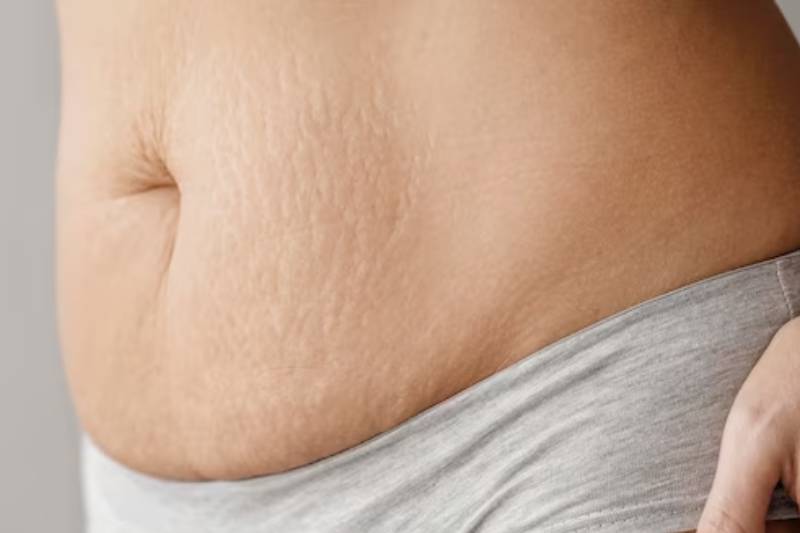What Causes Stretch Marks: How To Manage Them Naturally

Stretch marks are a common skin concern that affects many individuals, irrespective of age or gender. These streaks or lines on the skin's surface can appear on various body parts and are often a cause of concern for those who experience them.
In this article, we will explore the underlying causes of stretch marks, dispel common myths, and provide practical tips to manage and reduce their appearance.
Understanding the Physiology of Stretch Marks
Before we delve into the causes of these marks, it's crucial to understand their physiology. These marks occur when the skin is stretched beyond its natural capacity, causing the collagen and elastin fibers to rupture. This results in the formation of scars, which we commonly refer to as stretch marks.
What Causes Stretch Marks?
These marks, those visible streaks on the skin's surface, can be a source of concern for many individuals. These marks often appear due to various factors that cause the skin to stretch beyond its natural capacity.
Let's delve into the key causes of stretch marks and gain a deeper understanding of how they develop.
 Rapid Growth and Weight Changes
Rapid Growth and Weight Changes
During periods of rapid growth or significant weight changes, the skin is forced to stretch beyond its natural capacity. This can happen during puberty when adolescents experience growth spurts, causing the skin to expand quickly. Similarly, significant weight gain, such as during pregnancy, can lead to stretch marks, especially on the abdomen, breasts, hips, and thighs.
When the skin stretches rapidly, the collagen and elastin fibers in the dermis (the middle layer of the skin) may become damaged. These fibers are responsible for maintaining the skin's elasticity and structure. As they are stretched beyond their limit, they can rupture, leading to the formation of scars on the skin's surface, which we recognize as stretch marks.
Hormonal Changes
Hormones play a crucial role in the development of stretch marks. The hormone cortisol, which is released in response to stress, can weaken the skin's elasticity. High levels of cortisol can make the skin more susceptible to stretching and the formation of these marks. Moreover, hormonal changes during pregnancy and certain medical conditions can also influence the skin's ability to handle stretching.
During pregnancy, the body experiences hormonal shifts to support the growing fetus. These hormones can affect the connective tissues in the skin, making it more vulnerable to stretching and the appearance of these marks.
Genetic Predisposition
Genetics can also contribute to an individual's likelihood of developing stretch marks. If your parents or close relatives have experienced these marks, there is a higher chance that you may also develop them. Some people may have genetically determined differences in their skin's elasticity and resilience, making them more prone to these marks.
Prolonged Use of Corticosteroids
Corticosteroids are medications commonly used to treat various inflammatory conditions, such as asthma, allergies, and autoimmune diseases. However, their prolonged use, whether applied topically or taken orally, can compromise the skin's structure and lead to the development of stretch marks.
Corticosteroids affect collagen production and can impair the skin's ability to heal and regenerate, making it more susceptible to these marks. If you are using corticosteroids for an extended period, it is essential to discuss potential side effects with your healthcare provider.
Underlying Medical Conditions
Certain medical conditions can weaken the skin and contribute to the formation of stretch marks. For example:
- Marfan syndrome: This genetic disorder affects the body's connective tissues, including those in the skin. Weakened connective tissues can lead to these marks and other skin issues.
- Cushing's syndrome: This condition results from high levels of cortisol in the body. Excessive cortisol can negatively impact the skin's elasticity and contribute to the marks.
Managing these medical conditions through proper medical care and treatment can help reduce the risk.
Bodybuilding and Intensive Weightlifting
Individuals engaged in bodybuilding or intensive weightlifting often experience rapid muscle growth due to intense workouts and increased protein intake. This can cause the skin to stretch significantly, leading to the formation of marks.
As muscles grow, the skin must accommodate the increased size. If the skin cannot keep pace with the muscle growth, it may lead to the development of these marks, particularly in areas like the arms, shoulders, and thighs.
Lack of Proper Nutrition
A diet lacking essential nutrients can negatively impact the skin's health and resilience. Vitamins and minerals, such as vitamin C, vitamin E, zinc, and silica, play crucial roles in supporting skin health. These nutrients are involved in collagen production, which helps maintain the skin's elasticity and structure.
Inadequate intake of these nutrients can weaken the skin and make it more vulnerable to stretch marks. A balanced diet that includes a variety of nutrient-rich foods can contribute to better skin health and potentially reduce the risk of these marks.
How to Manage and Reduce Stretch Marks
These are common skin concerns that can be bothersome for many individuals. However, there are steps you can take to manage and reduce their appearance. Here's a detailed breakdown of the strategies:
 Moisturize Regularly
Moisturize Regularly
Moisturizing your skin on a regular basis is essential in maintaining its elasticity and reducing the visibility of these marks. When you apply moisturizers that contain ingredients like vitamin E, hyaluronic acid, or cocoa butter, you're providing your skin with the hydration it needs to stay supple and flexible.
These moisturizers work by replenishing the skin's natural oils, creating a barrier that helps lock in moisture and ultimately promoting the skin's ability to stretch without forming new stretching marks or making existing ones less noticeable.
Stay Hydrated
Drinking an adequate amount of water is crucial for maintaining the health and appearance of your skin. Hydration helps to improve the skin's elasticity, making it more resistant to stretching and the development of new stretching marks.
Water plays a vital role in maintaining the skin's overall health and function, and when your skin is well-hydrated, it's better able to withstand the forces that can lead to the formation of stretching marks.
Maintain a Healthy Diet
Eating a balanced and nutritious diet is beneficial not only for your overall health but also for the health of your skin. Nutrients like vitamin C, vitamin E, zinc, and silica are particularly important for maintaining skin strength and elasticity.
Vitamin C, for example, supports collagen production, which is a protein that contributes to the skin's firmness and structure. Including these nutrients in your diet through foods like fruits, vegetables, nuts, and whole grains can help improve your skin's resilience and reduce the likelihood of stretch marks.
Exercise Regularly
Engaging in regular physical activity has numerous benefits for your body, including your skin. Exercise promotes healthy circulation, which in turn supports the delivery of nutrients and oxygen to your skin cells.
Improved circulation can enhance the skin's overall health and appearance, making it more capable of withstanding the forces that cause stretch marks. Additionally, exercise helps to tone muscles, which can contribute to better skin texture and elasticity.
Gradual Weight Changes
If you're aiming to lose or gain weight, it's important to do so gradually and steadily. Sudden and drastic changes in weight can put excessive stress on the skin, increasing the risk of these marks.
By taking a gradual approach, you allow your skin to adapt to the changes more effectively, minimizing the chances of new stretch marks forming. Consulting a healthcare professional or a registered dietitian can help you develop a safe and sustainable weight management plan.
Use Topical Treatments
Certain topical treatments, such as those containing retinoids or alpha hydroxy acids (AHAs), can be effective in reducing the appearance of these marks. Retinoids, derived from vitamin A, can stimulate collagen production and promote cell turnover, which helps improve the texture and tone of the skin.
AHAs, on the other hand, exfoliate the outer layer of the skin, encouraging the growth of new, healthier skin cells. It's important to note that these treatments may take time to show results, and consistency is key.
By incorporating these strategies into your routine, you can effectively manage and reduce the visibility of stretch marks. While complete elimination may not always be possible, taking care of your skin through proper hydration, nutrition, exercise, and targeted skincare can go a long way in helping you feel more confident and comfortable in your own skin.
Conclusion
We have covered a detailed guide on What Causes Stretch Marks. These marks are a common concern faced by many individuals, and various factors, including rapid growth, hormonal changes, genetics, and certain medical conditions, can cause them. While they may not be entirely preventable, adopting a healthy lifestyle, proper nutrition, and targeted skincare can significantly reduce their appearance. Embracing your body and understanding that stretch marks are a natural part of life can empower you to feel confident and comfortable in your skin.
FAQs
Are stretch marks permanent?
While these marks are challenging to eliminate entirely, their appearance can be reduced through various treatments and lifestyle changes.
Can stretch marks be prevented during pregnancy?
While it's challenging to prevent these marks entirely during pregnancy, keeping the skin moisturized and maintaining a healthy diet can help minimize their severity.
Do stretch marks only occur in women?
No, these marks can occur in both men and women, though they are more commonly associated with pregnancy in women.
What causes stretch marks to develop?
These marks develop when the skin is stretched beyond its natural capacity, causing the underlying collagen and elastin fibers to tear. This tearing leads to the formation of visible lines or streaks on the skin's surface, commonly referred to as stretch marks.
Can cosmetic procedures remove stretch marks?
Cosmetic procedures like laser therapy and microdermabrasion can improve the appearance of these marks, but complete removal may not be possible.
Do stretch marks fade over time?
Yes, these marks may fade and become less noticeable over time, but they might not disappear completely.
Related Articles
- 30 Sep 24
Updating Soon The Episodes
- 30 Sep 24
Storing Essential Oils
- 30 Sep 24
What Are Essential Oils
- 30 Sep 24
Science Of Essential Oils
- 30 Sep 24
Happy To Receive Naari Samman Award
- 30 Sep 24
How Are Essential Oils Obtained?
- 30 Sep 24
Gateway To Africa - Istanbul
- 30 Sep 24
Et Global Indian Leader 2022
- 30 Sep 24
Can Essential Oils Help With Self-Care?
- 30 Sep 24
Pain Remedy Essential Oils
- 30 Sep 24
Asian - African Iconic Brand Awards 2022
- 30 Sep 24
Core & Pure Pain Buster Oil
- 30 Sep 24
Tea Tree Essential Oil From Core & Pure
- 30 Sep 24
Business Icon Award
- 30 Sep 24
